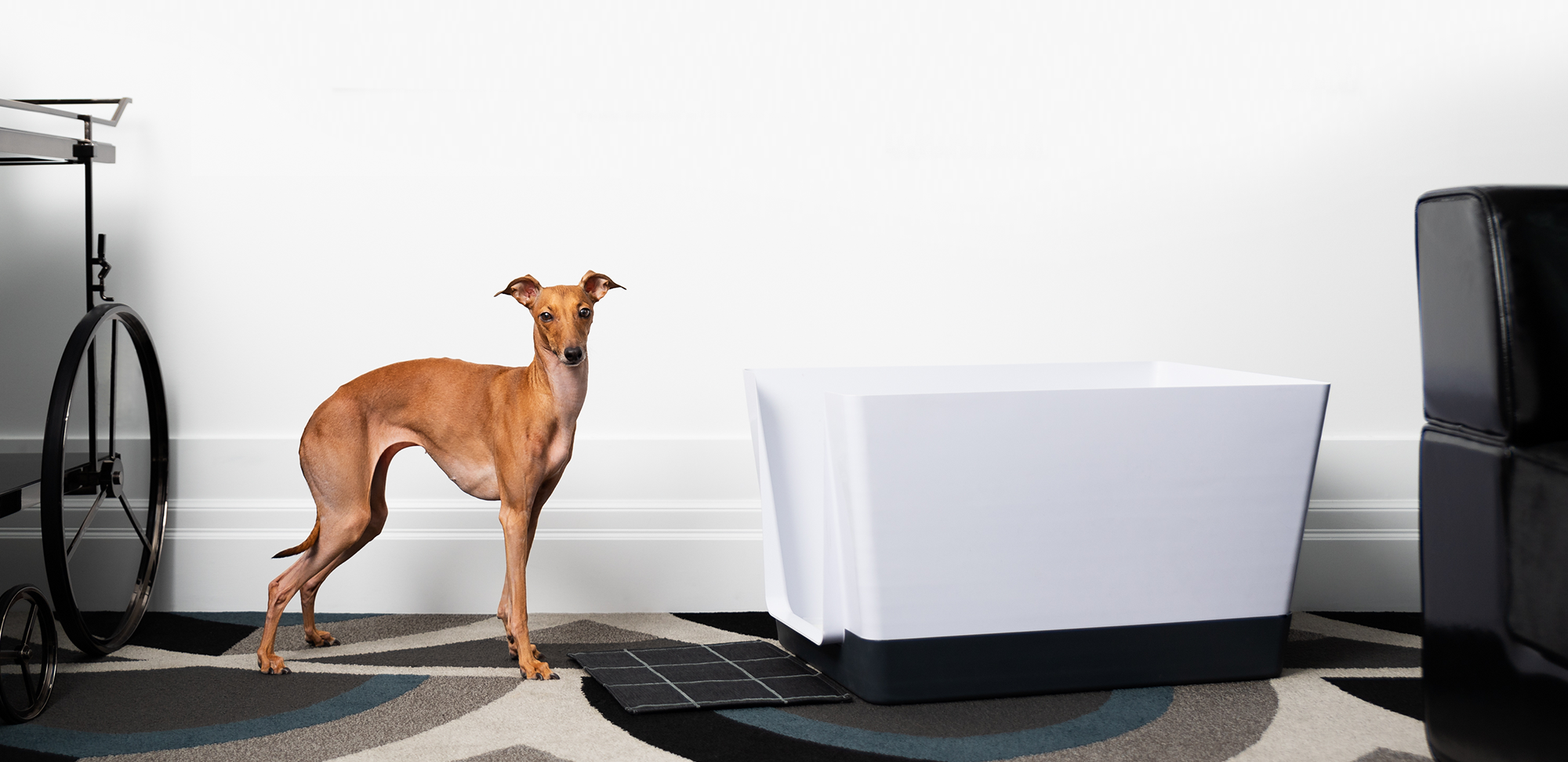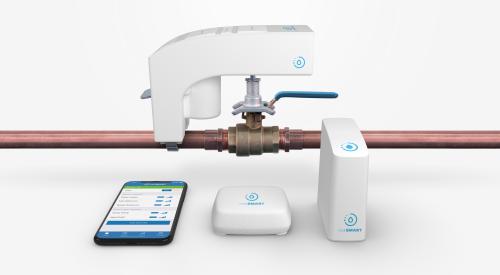As the universe of pet ownership expands, the demand for new homes and remodels that incorporate dog and cat amenities are increasing. Here are some tips and ideas to consider.
American have always loved their pets, but ownership has skyrocketed—with 84.6 million households owning pets in 2018. By contrast, only 52.8 million households had kids, says market and consumer data provider Statista.
According to a 2018 article in Forbes, nearly 70 percent of all U.S. households own a pet (with dogs being the most popular); most owners consider their pets family; and, collectively, U.S. pet owners spent $72.1 billion on their fluffy companions in 2018. Adding amenities to the house or remodel is simply an evolution of this trend.
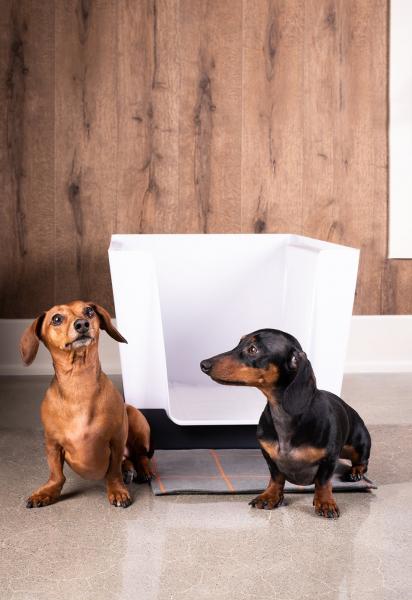
The Doggy Bathroom by Canadian designer Alain Courchesne is an indoor potty solution that the company says works efficiently for small dogs and is stylish enough to blend seamlessly with any decor. doggybathroom.com
Perhaps one of the more popular amenities is the built-in dog shower. Best located in a mudroom or laundry room, the shower is typically enclosed on three sides, tiled, and equipped with a handshower and a leash hook to hold the dog in place. If the home has multiple dogs, consider installing a commercial dog tub a couple of feet off the floor to prevent back pain and building a tiled surround for a more residential look, says Heather Lewis, AIA, principal of Animal Arts, a Boulder, Colo.-based architecture firm specializing in commercial animal care facilities. Alternatively, designer David Burcher, CKD, of New York-based In House Kitchen Bath Home, suggests using a shower pan and raising it 2 to 3 feet.
Showers are often part of a larger, designated pet zone that might include undercounter nooks for sleeping or feeding, a water source for refilling bowls, food prepping, and built-in storage for pet accessories.
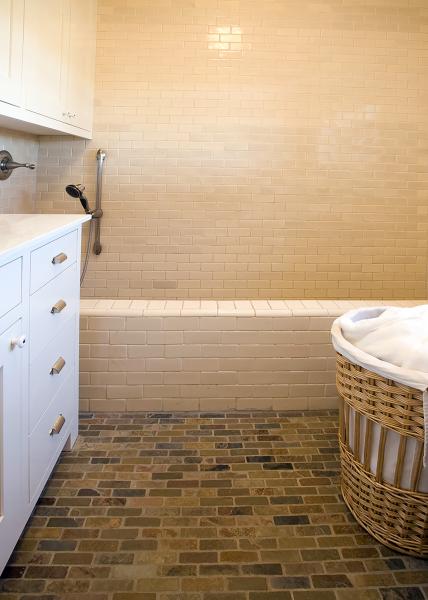
Architect Tim Barber created this doggy wash station in a laundry room. Photo: Tim Barber
Plan for food storage and preparation during the design process, so “it’s not an afterthought,” says Lewis. Rather than just leaving dry kibble in its bag or a Tupperware container, pullout trash bins and scoops help keep food tidy, readily accessible, and rodent free. Integrating food and water bowls into pullout drawers and undercounter nooks keeps them off the floor, where they can become trip hazards. Homeowners with pets who have special health needs may find an undercounter refrigerator convenient for storing fresh food or medication, says Burcher.
For cat owners, the pet zone might incorporate a custom cabinet that obscures the litter box, which the feline accesses by climbing through a hole. Designer Grace Kelly, principal of Long Island, N.Y.-based Kitchen Designs by Ken Kelly, has designed these cabinets with motion-activated ventilation that expels odors to the outside. Another option is to install a quiet bath fan in the room.
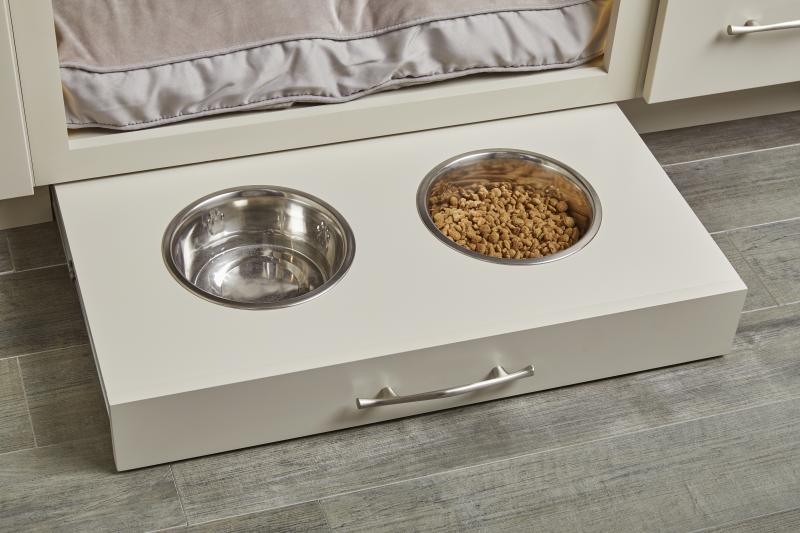
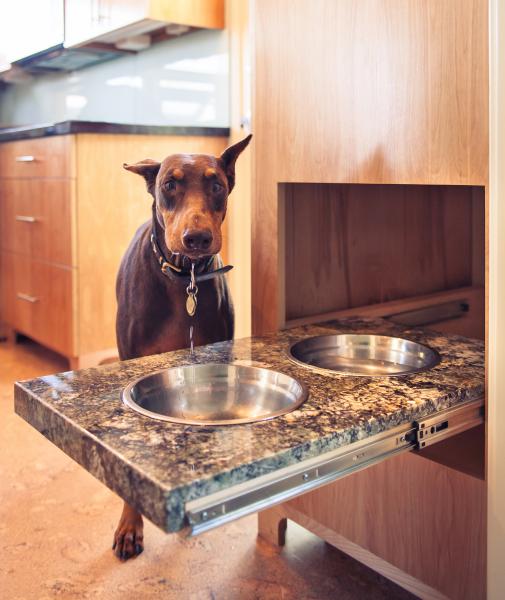
Left: Wellborn Cabinets offers a pull-out dog feeder in the toe kick. Right: Architect Tim Barber designed a pull-out dog bowl using cabinet slides. Photo: Charles-Ryan-Barber
The Internet abounds with other options for concealing litter boxes, but designer Kate Benjamin, founder of Hauspanther, a resource for cat products and author of New York Times bestsellers Catification and Catify to Satisfy, notes that problems with litter box use often stem from not having the right number of boxes, the right size, or the right location. Cats do not like to share litter boxes. Ideally, each should have its own plus an extra, preferably in separate areas, Benjamin says. Some cats will not use an enclosed litter box “so try different things to see what the cat responds to the best,” Lewis adds.
Boxes should avoid locations that are high-traffic, noisy, or cold, but should still be accessible enough to ensure regular cleaning, says Benjamin. To trap litter from the cat’s paws, add a mat, such as the Black Hole, and provide storage nearby for bags of litter, scoops, cleaning supplies, and extra cat beds.
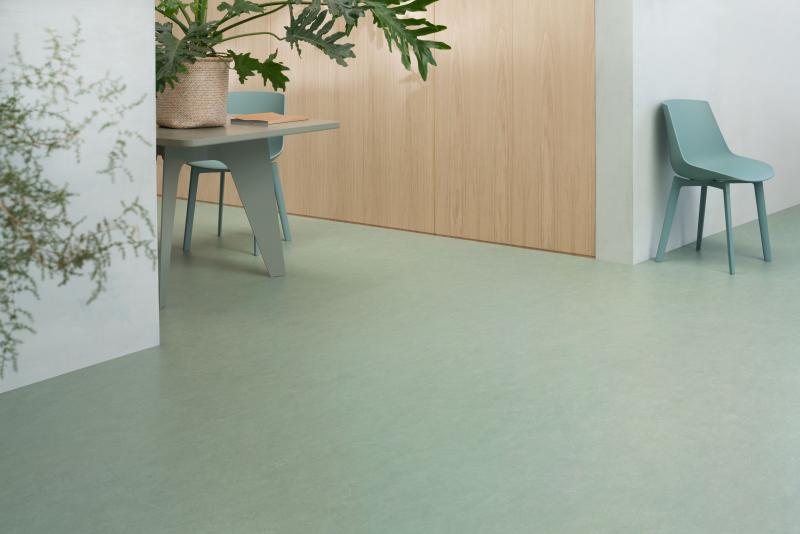
Forbo Marmoleum is a low-maintenance floor that can be cleaned up easily after accidents.
Choose flooring that is durable and slip-resistant. Lewis is a fan of luxury vinyl tile, which provides excellent traction for paws and whose tight joints prevent urine from seeping into cracks. Natural linoleum is also maintenance-light and seamless. Ceramic tile is another option, but steer clear of high-gloss finishes.
For walls, opt for a high-performance, zero-VOC paint in calming neutrals and cool colors. Beef up the entry and doorways, which can take a beating from leashes, running dogs, and kids, with wood. Because dogs and cats often lick themselves and rub up against surfaces, be wary of materials that splinter or have finishes that may be toxic if ingested, says Tim Barber, AIA, principal architect and owner of Los Angeles-based Tim Barber Ltd. He also notes that baseboards and windowsills can become chew toys for puppies.
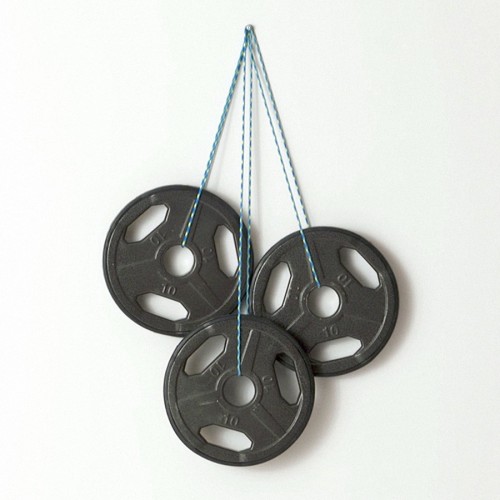
Habito impact resistant drywall by CertainTeed is extremely tough and is ideal in high-traffic areas or in pet rooms where walls are susceptible to scratches.
Having a personal retreat, especially in households with small children, is important for both dogs and cats, but the need is more critical for the latter. A crate, built-in nook, or furniture piece in a corner or under a staircase with a view of the room might calm a dog, but cats prefer their safe spaces elevated to better survey their environment, says Benjamin. Lewis adds, “When your cat runs and hides under the bed, that’s sort of a last resort.”
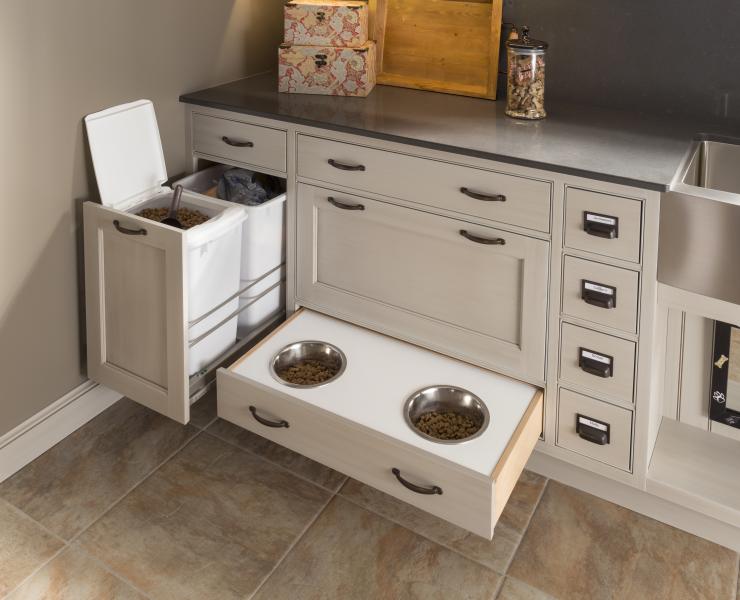
Wood-Mode offers pullout feeding bowls and food storage.
Be intentional about providing places for cats to relax and climb. “Ideally, you want to create a walkway that goes around the entire perimeter of the room without touching the floor,” Benjamin says. Some cat enthusiasts have installed cat-friendly ramps and shelves that visually integrate with the home’s architecture, but a combination of, say, a cat tree, a windowsill and furniture may also do the trick.
“We also try to isolate beautiful display cabinets so it becomes less appealing than other areas,” says Barber. “Cats are real jumpers.” Nevertheless, if installing cat shelves and walkways, make sure they’re not too far apart for safe jumping or too high that the cat can’t be easily reached.
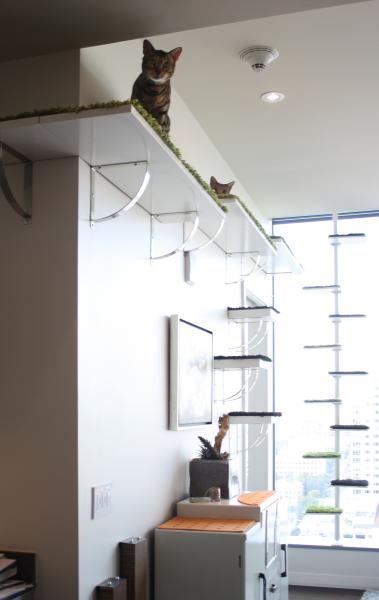
Because cats prefer elevated safe spaces, designer Kate Benjamin recommends intentionally providing places for cats to relax and climb. A walkway that goes around the entire perimeter of the room without touching the floor is highly recommended.
Pet doors provide dogs with regular outdoor access and can be installed in solid doors, sliding glass doors, and walls. Electronic doors allow the dog to come and go freely while keeping other animals out. Of course, make sure the backyard and front are properly fenced. A fence with a smooth surface on the yard side or a Coyote Roller on top can prevent dogs from climbing out and escaping, says Lewis. Yards should also be free of metal landscape edging (a common source of injury) and have open grass areas for playing.
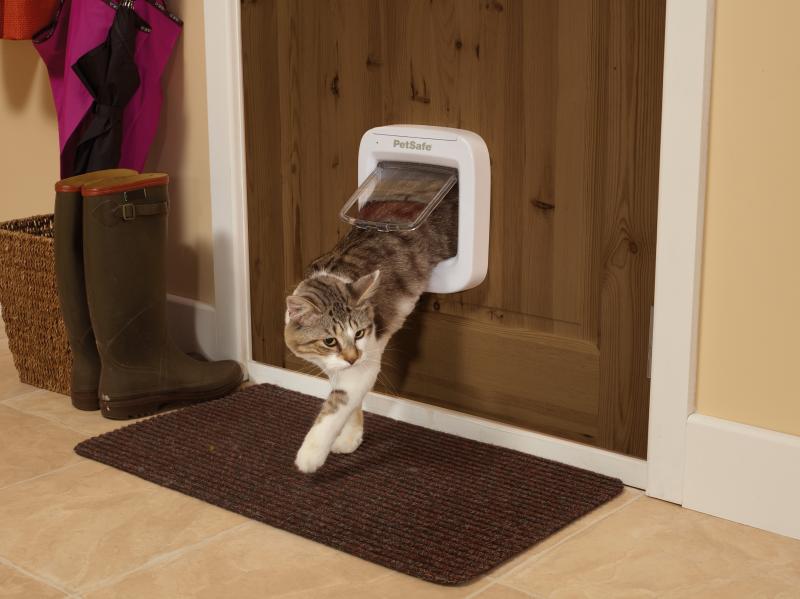
The PetSafe Microchip Cat Door gives cat freedom to come and go while keeping unwanted friends outside.
Cats also benefit from being outside, but only in safe, enclosed areas. “Catios” are increasingly popular and can be as simple as a small, dedicated section of the patio with shelves and cat toys. They can get more elaborate from there. For a Florida couple, architect Mario Arbore, who founded Square Paws, a maker of cat furniture and environments, created a screened-in Japanese-garden-themed catio featuring a bright red bridge, teahouse, and plenty of places for climbing.
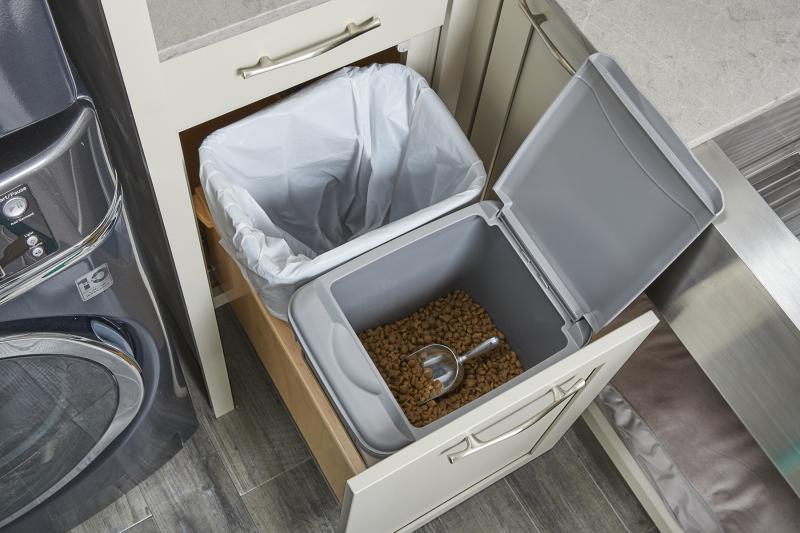
Wellborn Cabinets waste basket are used here for food storage bins.
Lewis offers other tips to keep in mind: Avoid window coverings with long cords that can entangle pets and make sure appliances are installed without gaps that could become hiding places. Use more robust screens to prevent dogs from running through them and, when possible, opt for LED lighting, which is better suited for how dogs and cats see.
There are a myriad other ways to ensure a home is both human- and pet-friendly. If you’re unfamiliar with either animal, do a little research, speak to the owner about their unique animals, and, if it’s a cat, Benjamin suggests visiting a local cat café for inspiration.
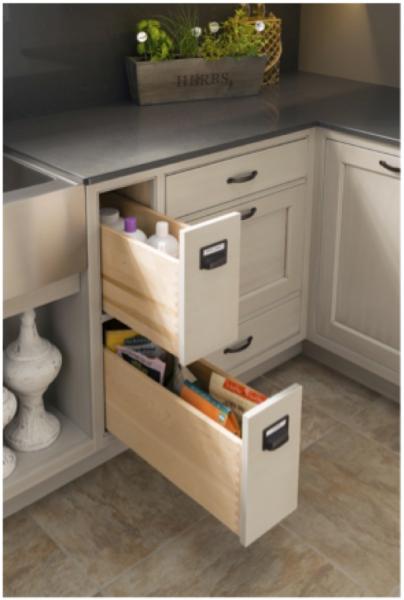
WoodMode storage pullouts are ideal in a laundry room for storing pet cleaning supplies, treats, and other accessories.
